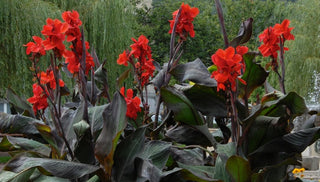
Flowers on a green-leaved variety of canna called Panache.
Cannas lilies are great summer flowers that can be grown in containers or in the garden. Their bold foliage and exotic flowers make a big splash with little effort. Here's how to grow these tender beauties:
Originally from the West Indies and South America, cannas are one of the showiest summer bulbs you can grow. These lush tropical plants produce large — sometimes colorful — leaves, and tall flower stalks with vibrant blossoms. Depending on the variety, cannas can grow a few feet tall to more than 10 feet tall. Dwarf varieties look great in large containers combined with petunias, sweet potato vines, and other low-growing annuals. Larger varieties make a strong, elegant statement planted at the back of flower beds or grouped together in showy islands of color. Because they tolerate moist soils, cannas can also be planted along ponds or in a wet spot in the yard.
Cannas are generally grouped by leaf color. One of the most popular green-leafed varieties is City of Portland, which has soft, salmon-colored blooms. For containers, consider the dwarf cannas, which grow to about 3 feet tall. Ambassador is similar in size, but it has reddish leaves and red flowers.
Planting and Care: Because they are topical plants, cannas thrive in full sun, with plenty of summer heat and consistently moist soil. Wait until the soil has warmed and all threat of frost has passed before planting cannas outdoors. Rhizomes should be planted horizontally, 4 to 6 inches deep, and spaced 1 to 2 feet apart. For earlier flowers, cannas can be planted in pots and started indoors or in a greenhouse about one month before mild weather arrives.
Cannas grow and flower best when fertilized monthly. Keep plants well watered and weeded. Because cannas are tropical plants, they will overwinter outdoors only in frost-free areas (USDA zones 9 and 10). In most areas you'll need to dig up the tubers in fall and store them indoors. After frost kills back the foliage, dig the tubers, and store them in a cool, dark, frost-free place.





